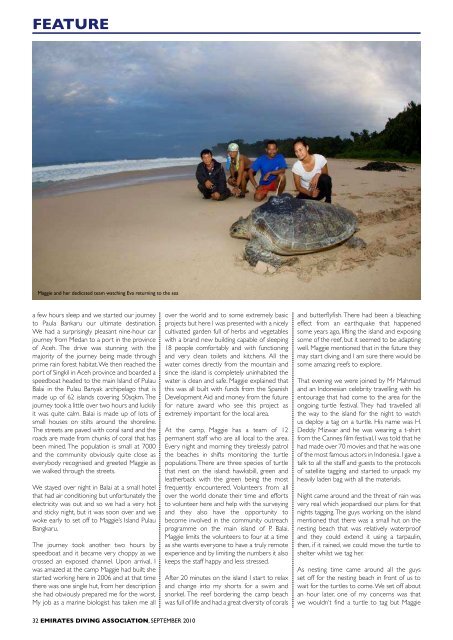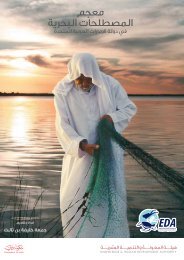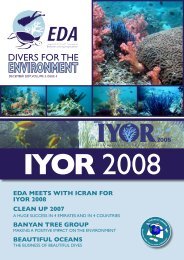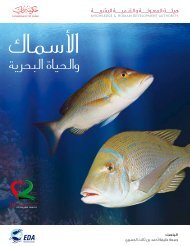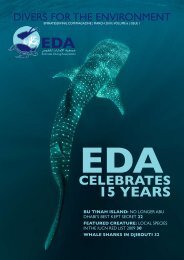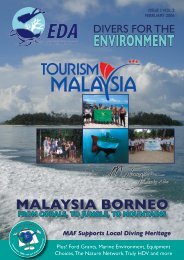NEWS - Emirates Diving Association
NEWS - Emirates Diving Association
NEWS - Emirates Diving Association
You also want an ePaper? Increase the reach of your titles
YUMPU automatically turns print PDFs into web optimized ePapers that Google loves.
FEATURE<br />
FEATURE<br />
explained that there are turtles every single<br />
night nesting on this Island. The nesting beach<br />
is 1.9km long and is a 30-minute trek through<br />
the rain forest. Just as we set off the heavens<br />
opened and rain started to pour down. The<br />
track that we were walking on turned into a<br />
small stream and we all started slipping and<br />
sliding as we progressed. I glanced back at<br />
H. Deddy Mezwar and his followers and to<br />
my surprise they seemed to be enjoying the<br />
experience.<br />
The Yayassan Palau Banyak living quarters<br />
Maggie and her dedicated team watching Eva returning to the sea<br />
a few hours sleep and we started our journey<br />
to Paula Bankaru our ultimate destination.<br />
We had a surprisingly pleasant nine-hour car<br />
journey from Medan to a port in the province<br />
of Aceh. The drive was stunning with the<br />
majority of the journey being made through<br />
prime rain forest habitat. We then reached the<br />
port of Singkil in Aceh province and boarded a<br />
speedboat headed to the main Island of Pulau<br />
Balai in the Pulau Banyak archipelago that is<br />
made up of 62 islands covering 50sqkm. The<br />
journey took a little over two hours and luckily<br />
it was quite calm. Balai is made up of lots of<br />
small houses on stilts around the shoreline.<br />
The streets are paved with coral sand and the<br />
roads are made from chunks of coral that has<br />
been mined. The population is small at 7000<br />
and the community obviously quite close as<br />
everybody recognised and greeted Maggie as<br />
we walked through the streets.<br />
We stayed over night in Balai at a small hotel<br />
that had air conditioning but unfortunately the<br />
electricity was out and so we had a very hot<br />
and sticky night, but it was soon over and we<br />
woke early to set off to Maggie’s Island Pulau<br />
Bangkaru.<br />
The journey took another two hours by<br />
speedboat and it became very choppy as we<br />
crossed an exposed channel. Upon arrival, I<br />
was amazed at the camp Maggie had built; she<br />
started working here in 2006 and at that time<br />
there was one single hut, from her description<br />
she had obviously prepared me for the worst.<br />
My job as a marine biologist has taken me all<br />
over the world and to some extremely basic<br />
projects but here I was presented with a nicely<br />
cultivated garden full of herbs and vegetables<br />
with a brand new building capable of sleeping<br />
18 people comfortably and with functioning<br />
and very clean toilets and kitchens. All the<br />
water comes directly from the mountain and<br />
since the island is completely uninhabited the<br />
water is clean and safe. Maggie explained that<br />
this was all built with funds from the Spanish<br />
Development Aid and money from the future<br />
for nature award who see this project as<br />
extremely important for the local area.<br />
At the camp, Maggie has a team of 12<br />
permanent staff who are all local to the area.<br />
Every night and morning they tirelessly patrol<br />
the beaches in shifts monitoring the turtle<br />
populations. There are three species of turtle<br />
that nest on the island: hawksbill, green and<br />
leatherback with the green being the most<br />
frequently encountered. Volunteers from all<br />
over the world donate their time and efforts<br />
to volunteer here and help with the surveying<br />
and they also have the opportunity to<br />
become involved in the community outreach<br />
programme on the main island of P. Balai.<br />
Maggie limits the volunteers to four at a time<br />
as she wants everyone to have a truly remote<br />
experience and by limiting the numbers it also<br />
keeps the staff happy and less stressed.<br />
After 20 minutes on the island I start to relax<br />
and change into my shorts for a swim and<br />
snorkel. The reef bordering the camp beach<br />
was full of life and had a great diversity of corals<br />
and butterflyfish. There had been a bleaching<br />
effect from an earthquake that happened<br />
some years ago, lifting the island and exposing<br />
some of the reef, but it seemed to be adapting<br />
well. Maggie mentioned that in the future they<br />
may start diving and I am sure there would be<br />
some amazing reefs to explore.<br />
That evening we were joined by Mr Mahmud<br />
and an Indonesian celebrity travelling with his<br />
entourage that had come to the area for the<br />
ongoing turtle festival. They had travelled all<br />
the way to the island for the night to watch<br />
us deploy a tag on a turtle. His name was H.<br />
Deddy Mizwar and he was wearing a t-shirt<br />
from the Cannes film festival, I was told that he<br />
had made over 70 movies and that he was one<br />
of the most famous actors in Indonesia. I gave a<br />
talk to all the staff and guests to the protocols<br />
of satellite tagging and started to unpack my<br />
heavily laden bag with all the materials.<br />
Night came around and the threat of rain was<br />
very real which jeopardised our plans for that<br />
nights tagging. The guys working on the island<br />
mentioned that there was a small hut on the<br />
nesting beach that was relatively waterproof<br />
and they could extend it using a tarpaulin,<br />
then, if it rained, we could move the turtle to<br />
shelter whilst we tag her.<br />
As nesting time came around all the guys<br />
set off for the nesting beach in front of us to<br />
wait for the turtles to come. We set off about<br />
an hour later, one of my concerns was that<br />
we wouldn’t find a turtle to tag but Maggie<br />
So after what seemed like an eternity, we<br />
emerged from the forest completely soaked<br />
and covered in mud and we started the walk<br />
down the beach to find the guys. I didn’t<br />
mention anything to Maggie but I was thinking<br />
that there was no way that we would be able<br />
to attach a sat tag in these conditions but I<br />
carried on regardless. Soon we came to a river<br />
that was crossing the beach. Maggie stopped<br />
and started to shine her torch up and down<br />
the water and explained that she was looking<br />
for crocodiles that were often spotted in the<br />
water. She then made a mad dash for the<br />
other bank and called for us to proceed. With<br />
visions of wildebeest crossing the rivers on<br />
their annual migrations through East Africa<br />
I jumped into the water and ran across as<br />
quickly as I could. We all made it across the<br />
river alive and with all our limbs in tact and<br />
we soon came across the patrolling men who<br />
informed us that they had a turtle for us. They<br />
took us to a clearing in the vegetation and I<br />
stepped through to find a huge green turtle<br />
in a perfectly made holding box and sheltered<br />
under a tarpaulin attached to a little shack and<br />
I suddenly began to realise that the tagging<br />
may actually be possible.<br />
We all scrambled into the dryness of the<br />
shelter and I began to clean the carapace of the<br />
turtle so that we could start the attachment. It<br />
was around 10pm when we started working<br />
and after six hours of applying different types<br />
of epoxies and paints we were ready to go<br />
and the turtle was ready to be released. We<br />
were all exhausted including the turtle but we<br />
mustered all the strength we could and lifted<br />
her back onto the beach where she could<br />
make her way back into the water. Maggie<br />
named her ‘Maia’ after her three year old<br />
daughter and we all watched whilst she made<br />
her way back to the sea. This was the first time<br />
a sea turtle had been satellite tagged in the<br />
whole of Sumatra and so we were all very<br />
excited to see where ‘Maia’ would travel.<br />
We then made our way back along the beach,<br />
across the crocodile river and back through<br />
the now water soaked rainforest. Upon our<br />
return I quickly showered and washed off all<br />
the mud and then fell exhausted into my bed.<br />
I awoke the next day wrapped in my mosquito<br />
net that had fallen down during the night.<br />
Luckily the mosquitoes were not bad at all and<br />
I had only fallen victim to a few bites. I looked<br />
out of the window to see the forest and<br />
Maggie and I attaching the first of the transmitters<br />
beach and realised that the three days I had<br />
here were simply not enough. It was still early<br />
but the sun was high and bright. I walked to<br />
the communal area were I was greeted with<br />
locally produced coffee and banana pancakes<br />
served with limejuice and fresh coconut<br />
shavings, delicious!<br />
I then spent the morning snoozing in the<br />
hammocks and listening to the sounds of the<br />
jungle. Later I started to prepare for the next<br />
tag to be applied. Nightfall soon came and the<br />
patrol team set off on the jungle trek to the<br />
nesting beach and we shortly followed. Luckily<br />
this night there was no rain and we all stayed<br />
dry.<br />
The second tagging was much like the first<br />
and a great success. The turtle was tagged a<br />
lot later in the night and so by the time we<br />
had finished morning time had come around<br />
and we managed to get some nice shots of<br />
the turtle returning to the sea. The second<br />
turtle was named Eva after one of the main<br />
sponsors of the projects daughter.<br />
Upon returning to the camp I managed to<br />
get a few hours sleep before starting the<br />
long journey back to Dubai. On the way we<br />
stopped to see the local turtle festival that was<br />
being held on the main island and attracted<br />
lots of Indonesian celebrities. The turtle project<br />
had managed to create something very unique<br />
in this region and everyone respected all the<br />
staff involved in the project and seemed to<br />
embrace the idea of protecting the turtles and<br />
grateful for the steady flow of tourists coming<br />
to the islands for a turtle experience.<br />
If you would like to volunteer with Yayassan<br />
Palau Banyak then please visit www.aceh<br />
turtleconservation.org for more information.<br />
I would recommend a minimum of three weeks<br />
to really relax and enjoy the experience.<br />
If you find a stranded or injured turtle in Dubai<br />
then please call the DTRP on +971 4 310<br />
7198.<br />
32 EMIRATES DIVING ASSOCIATION, SEPTEMBER 2010 SEPTEMBER 2010, EMIRATES DIVING ASSOCIATION 33


